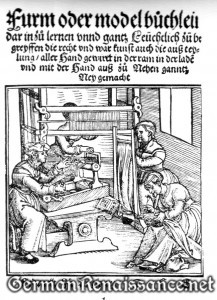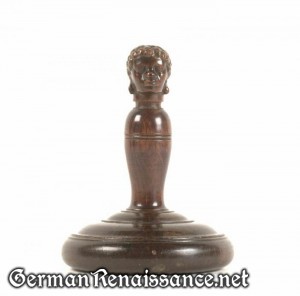In addition to folding pleats into fabric, you can also press them in using a variety of techniques.
No manual from the 15th or 16th centuries is known to exist that explains the press folding method of creating pleats, so it is unclear if the sempstresses of this era would have employed such a method to pleat their cloth. However, we can make some educated guesses based on the extant pleated fabric found in Castle Lengberg—specifically, Find 121 ( a section of pleats from a shirt sleeve cuff created in the late 15th century) was found to have a sharp pleat edge which may have caused the cloth to break along the edges of the linen as it dried over time (Nutz, 81). An edge sharp enough to break the linen fibers over time would likely need to be pressed into the linen with something like a smoothing or creasing tool, or perhaps a frame that tightly compressed wet fibers. One possible tool which could be used to fold the fabric is shown in the image below from the cover of Furm oder model büchleini, which depicts a frame with what appears to be pleated and secured (pressed or clamped) fabric. No extant frames which visually match this description are known to exist, however, so it is not clear how this tool functions (and I suspect it has an entirely different function in pleatwork–more on that later in the guide).
Another possibility for pressing the folds into the linen may have been the wooden or marble slickenstone (similar to the one shown below), or linen smoother, which was used to smooth creases out of damp linen after it had been washed and starched. The same tool that could remove creases would have been able to add creases if the fabric was damp and folded.
Recently I tried to construct a device that would press the folds into a piece of linen. It was a board made of ridges of wood, set at 45 degree angles, upon which you placed a piece of wet linen. Then a second ridged board was placed on top of the linen, perfectly matching the board below. The idea is that you would press the two boards together to create ridges in the fabric and as the linen dried the ridges would become more or less permanent folds and could then be sewn together to secure them. This experiment was a failure, however, because the tension of the fabric is so strong that it does not fold when the ridged boards are pressed into it. It’s possible that if the top set of ridges was made to be flexible that you could manipulate the fabric into the press better, but a flexible set of ridges seems a bit too unlikely for our ancestors to have fiddled with. I am still considering ideas for it, though.
Update: Thanks to a reader (Sarah), I’ve since learned that the Egyptians liked to pleat their clothing. A finely pleated tunic is still in existence in the Louvre. It’s unknown how the Egyptians pleated their cloth, but one theory is that carved, ridged boards like this one at the Museo Archeologico Nazionale (inventory 2691) may result in a pleats if wet, starched fabric is pressed onto it. It looks similar to my failed pleating press, except it is just one board, not two. Thus, I think my pleating press deserves more testing. This article on “Costume in New Kingdom Egypt” (Sasson, 1995) theorizes how Egyptians may have used this pleating press, and even comments that tests were undertaken with them.
There is another modern method of pressing folds into cloth, used today by couture fashion workers. They have a device called a Pleater (or Pleating Board / Pleating Press) which involves folding fabric (usually polyester) around a sort of flexible, accordion-style frame and then heated in some fashion (you can see it in action in this video). This doesn’t seem likely to be a 15th or 16th century practice because of the frame’s need to be flexible and the fact that this works best with man-made fabrics, but I thought it worthy of mention here for the sake of completeness. If this method is appealing, you can make one yourself with this tutorial.
Next up: The Gather Method of Creating Pleats
Previous: The Fold Method of Creating Pleats
Go to the Introduction (Main Page) or the Table of Contents



